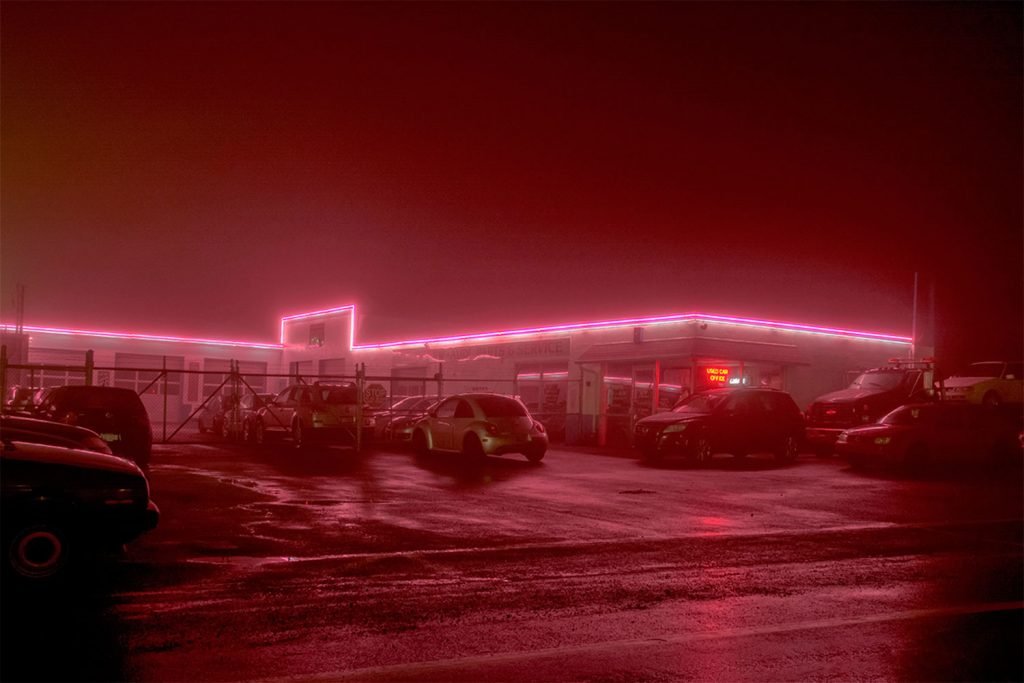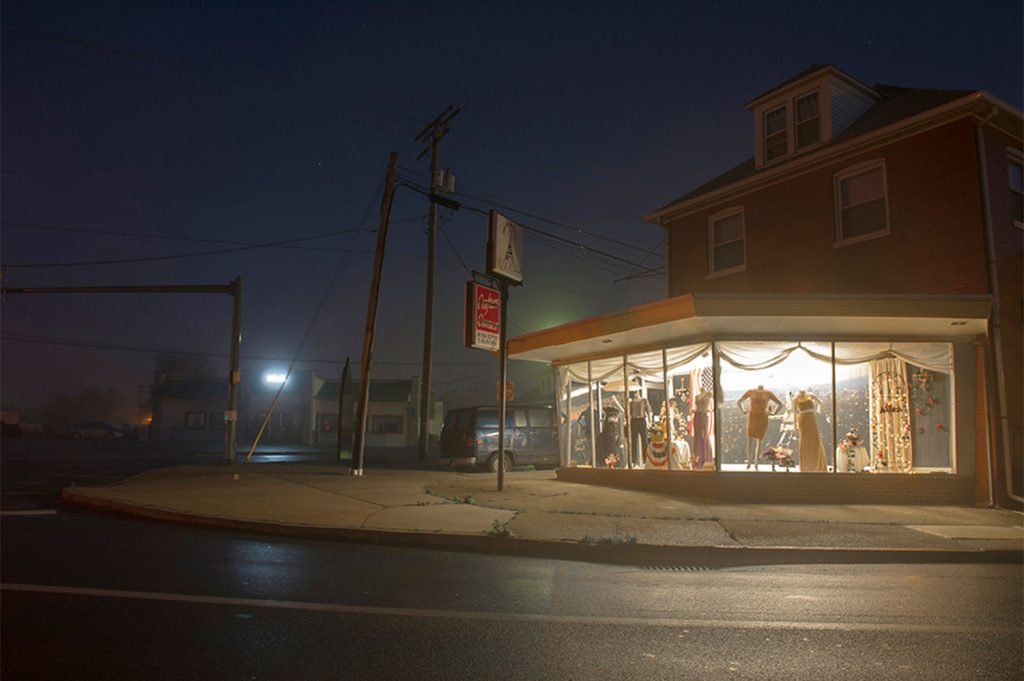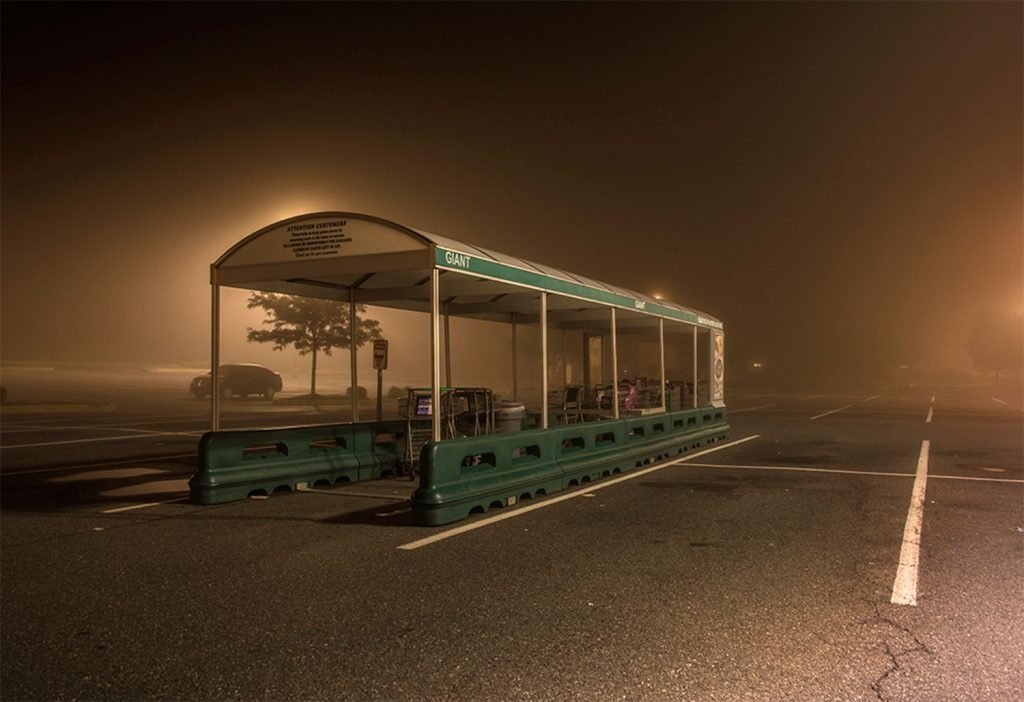Starting in the fall of 2015, Peter Ydeen has been photographing at night in the Easton Pennsylvania area. Starting with images of George Tice’s elegant night shots in mind, it soon matured into much more than he had expected. The night has its own visual rules, its own color wheel, and its own ethereal presence. The series depicts these American towns in a mystical array of endless stages.
Matteo Cremonesi: What is the story being told by Easton Nights?
Peter Ydeen: Easton Nights is a story of small town America as told by the places we create and live in. The urban environment is organic, constantly growing, dying and reshaping itself, but purely determined by the people who live there. It is a story of a romantic world where we live and sleep but often ignore.
MC: Was there a significance is there for you in showing “Easton Nights” in Easton at Brick and Mortar Gallery and then again at Saint Josephs University in Philadelphia?
PY: Photography is a conversation, and who better to talk to than peoples whose world I record. The emphasis of the series is to unearth the beauty and romance in the worlds the people of the Easton area created. Showing the photographs at Brick and Mortar was a welcome opportunity to share these graceful environments with the people who conceived them, and in Brick and Mortar’s elegant space run by two people, Chaz Hampton and Tom D’Angelo, who have a dedicated affection for the area. Moving the show on to Saint Josephs, in Philadelphia, was also important, as it brings the show to a major city, while still connecting to many of the viewers, as it reflects the places many of the people came from. It is also the first step in my desire to have the show travel out of Easton and around Pennsylvania.
MC: You talk about the disconnect between Easton and the nearby cities of New York and Philadelphia. How does this affect the work?
PY: The disconnect between the Easton area and the nearby cities of New York and Philadelphia is key to the story told by Easton Nights. In the beginning I took it to be negative, as I have long considered myself a New Yorker where I have maintained a business for many years. As the project continued, the unique qualities of the Easton began to emerge. The Lehigh Valley, where Easton sits, has almost one million people. Despite this, there is no downtown. Instead, it is a sea of almost 100 towns, many Main Streets and microcosms, and many nationalities. Its’ history starts before the creation of this country and goes through many highs and lows being the home to many industries, and still it is vibrant and growing. It is not a bedroom community for another place but has its own will, serving as a living museum of Americana.
MC: Easton Nights is a project done in a purely nocturnal timeframe. What are the characteristics of these settings which attract you, and what draws you to investigate the night?
PY: There many aspects of night photography which are unique and special. The lighting parallels stage lighting where objects, vignettes or areas are specifically lit. Because of this lighting, the viewer is invited in to be a part of the image, as opposed to many day photographs, which treat the image as two-dimensional. This is complemented by the emptiness which emphasizes the spaces and gives them life. Together, these aspects create an animated world, which is dreamlike and surreal, but still has the “capture” as its basis. It reflects the romantic nature of our everyday world, which is much more difficult to see in daytime photography.
MC: Do you believe that the desolation of the places you talk about belongs to the hours of darkness and which identity do you think emerges?
PY: The word “desolation” has a negative context; and my initial impression of the Easton area was just that. But as time went by it became clear that “desolation” is not what I found. There is emptiness, but not despair and not loneliness. What emerged was a relentless energy that is brought forward in the night and then subjugated in the day. The landscape hums and comes together as a thing in itself, every bit as alive as the people who created it. Magic is pulled from reality. If I needed to use a few words describing the identity of the night, it would be “romantic energy”.
MC: The way you treat photography is extremely spectacular, don’t you think that his spectacularization produces a noise in contrast to the silence of these places and these moments?
PY: I have often been told there is a consistent style to my work, and though I attempt to not dwell on it, for fear of self-consciousness, this spectacularization would probably be a common denominator in my style and approach to night photography. There is most definitely the contrast and it brings us back to the way night photography emphasizes different aspects of our environment. It brings a dramatic “Ta dahhh!” to our common day world.
MC: The immobility of your work sometimes seems to refer to an existential reflection; is that right?
PY: Self-consciousness is an enemy of mine, especially when making art. There is very little philosophy which goes into its’ making, but that said, in hindsight I would agree. If you take existentialism as our creating our own values and meaning to life, both consciously and subconsciously, then my work fits that description. When I am out shooting, it is totally responsive and I work quickly moving from place to place. The reflection comes later as I see what my camera gives to me.
MC: There is a great tradition of American landscape photography that looks at urban spaces, from William Eggleston to Joel Sternfeld up to Stephen Shore and Joel Meyerowitz. How does your work fit into the experiences of these authors?
PY: Of the four photographers mentioned, none were a direct influence, though indirectly, all of them were. Coming from a painting and sculpture background, I did not look at much photography when I first started diving into the field. But have been around art daily for my whole adult life, individual photographs from all of these photographers had impressed me over time. Most importantly, they paved the way for the tradition of Urban Landscape Photography, which provides the tenets underlying my work.
MC: Which photographers or artists do you consider to be your major influences?
PY: The only photographer who was a direct influence on my work was George Tice, whom I still consider to be the most poetic of the Urban Landscape photographers. I would place my major influences to be with the work of painters from the early to mid 20th century, particularly American Modernism. Particular artists include Charles Burchfield, whose work tried to capture something beyond the visual, Charles Sheeler and Arthur Dove. There is also a great influence from 19th century Romantic writers such as ETA Hoffman and Charles MacDonald. Whereas the American Modernists were adamant about the two-dimensionality of art, which has influence in much of my daily work, the Romantic writers attempted to bring the reader inside their worlds, which is where my night work has drifted. A recurring element of my work has been the desire to have a viewer spend time inside the work as opposed to a singular image, which is an object in itself. In this sense Easton Nights uses the elements of Modernism in the composition, space and design, but the elements of Romantic literature to engage the viewer and have them come inside.
MC: What are your future plans for your photography?
PY: I am currently working on organizing Easton Nights into more of a narrative. This is being done with both the creation of a book and an artist presentation, which divides the photographs into chapters exploring different aspects of the story than bringing the viewer through the series.
This structuring will also follow into how I present the shows, which I am hopeful will continue to travel around Pennsylvania as well as other places. The next show of Easton Nights will be back in Easton at the State Theater galleries January through March 2019. I’m also developing the day side of the story “Valley Days” as well as working on various mini-series based on my travels.
–
website: Peter Ydeen
Instagram: peterydeen
–
copyright © Peter Ydeen and PHROOM, all rights reserved
–











